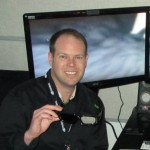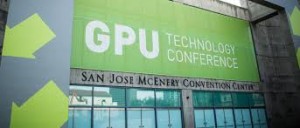The GPU Technology Conference is coming up March 24 – 27 in San Jose with a plethora of developer talks on everything from Numerical Algorithms to Languages & Compilers, Computational Physics, Computer Vision, Machine Learning, and Big Data Analytics. To learn more, we caught up with NVIDIA’s George Millington.
insideHPC: GTC is now in its fifth year. What are your goals for the conference this year and the coming decade?
 George Millington: Our primary goal is to continue delivering top-notch sessions, talks and tutorials about the many ways in which GPUs are enabling new innovation and discovery in a range of fields. At the same time, because we continue to see the use of GPU technology expand to new areas, we aim to continue broadening the scope and content of the show to reach new attendees in these emerging fields. These include such areas as cloud and mobile computing, machine learning, big data analytics, and more.
George Millington: Our primary goal is to continue delivering top-notch sessions, talks and tutorials about the many ways in which GPUs are enabling new innovation and discovery in a range of fields. At the same time, because we continue to see the use of GPU technology expand to new areas, we aim to continue broadening the scope and content of the show to reach new attendees in these emerging fields. These include such areas as cloud and mobile computing, machine learning, big data analytics, and more.
GTC is meant to be an event like no other to empower developers of GPU-accelerated applications. It was created for smart, innovative and driven individuals to network and share ideas with others within and outside of their fields – enabling them to get a first-hand look at what is possible when you apply GPU technology to some of the most difficult problems.
In the coming decade, we simply plan to make GTC bigger and better: Attracting more researchers, software developers, engineers and technology pros from around the world who are doing amazing things with GPUs.
insideHPC: Can you tell me more about the keynote speakers this year?
George Millington: We have an amazing line-up of keynotes this year. Our CEO, Jen-Hsun Huang will again kick things off with the opening keynote on Tuesday, March 25. If your readers have never heard him speak, they are in for a real treat. He plans on sharing the amazing new ways GPUs are pushing the envelope of scientific discovery, and the ways they are forever changing the way we work and play. Plus, he’ll take the wraps off a number of new GPU-related product, partner and customer announcements. And, in classic NVIDIA style, you can expect some amazing, never-before-seen keynote visuals. It’s not to be missed.
The day two keynote on Wednesday, March 26, will be given by Dirk Van Gelder and Danny Nahmias from Pixar. The two will show how Pixar is using GPU technology for the production of its feature films. In particular, they will talk about how GPUs provide Pixar artists with real-time feedback during the character animation process, enabling them to push the envelope of animation and scene illumination. They’ll provide several examples of this work from recent Pixar films.
Finally, director of the Neuroscience Imaging Center at the University of California, San Francisco, Adam Gazzaley, will give the third keynote on March 27. He’ll talk about his ground breaking work using GPUs and video games and real-time EEG feedback to enhance the human brain’s information processing systems. As we get older we normally lose some cognitive ability, for example, the ability to multitask. Professor Gazzaley’s unique approach to “exercising” the brain with video games demonstrates that some of this brain function can actually be improved.
insideHPC: GTC has always seemed to be very focused on collecting data—you even scan badges at the door of individual sessions. What kind of insight have you gathered over the years from attendees and how do you use that to improve the conference?
 George Millington: The purpose of the data collection is to make GTC better. By scanning badges, issuing surveys and collecting other information from attendees we learn what sessions, talks and speakers they like – so we can book more like them – and what they don’t like – so we can avoid them for future conferences. We want GTC to be a great experience overall, not just an informational event, and we use the data to make that happen year after year. For example, we learned through this data that attendees wanted more opportunities to have one-on-one connections with our technical staff. So, this year we’re hosting developer “hangouts” and orchestrating other ways for them with NVIDIA employees and peers.
George Millington: The purpose of the data collection is to make GTC better. By scanning badges, issuing surveys and collecting other information from attendees we learn what sessions, talks and speakers they like – so we can book more like them – and what they don’t like – so we can avoid them for future conferences. We want GTC to be a great experience overall, not just an informational event, and we use the data to make that happen year after year. For example, we learned through this data that attendees wanted more opportunities to have one-on-one connections with our technical staff. So, this year we’re hosting developer “hangouts” and orchestrating other ways for them with NVIDIA employees and peers.
insideHPC: Our core readership is all about HPC and for many, that involves accelerated computing with GPUs. What does GTC offer for the technical computing crowd?
George Millington: In short, we’ll have a ton of HPC content. There are nearly 100 sessions dedicated to supercomputing and HPC topics. This includes major scientific research enabled by these GPU-accelerate systems – everything from breakthroughs in cancer research and astronomy, to HIV research and new big data analytics innovation.
Attendees will also have access to HPC and accelerated computing experts that can help you with everything from learning what types of applications are designed for GPUs to actually helping you optimize your code. This includes hands-on-labs, tutorials and deep technical sessions on programming.
insideHPC: You just released Cuda 6. How important has Cuda been to the proliferation of accelerated computing?
George Millington: CUDA has been incredibly important to our success. The hardware is only as useful as the software that runs on it, and the continued innovations we’ve made to CUDA over the years–such as the Unified Memory feature in the latest version (CUDA 6)–is largely responsible for the surge in accelerated computing. CUDA has made it easier and faster for all types of developers to get maximum performance out of their GPUs. At the same time, the growing list of CUDA-supported apps means that developers are sure to find a CUDA app tailored for their specific work or area of research.
Another reason why CUDA has helped drive the use of GPU computing is through the hundreds of educational programs that have been created around the world. Today there more than 735 CUDA programming courses taught in universities and institutions worldwide, which are helping to groom the next wave of GPU programmers. [link: http://blogs.nvidia.com/blog/2014/02/25/cuda-by-numbers/]
But perhaps the main contribution CUDA has provided to the proliferation of accelerated computing is in the area of science. CUDA has enabled programmers and researchers across a large number of scientific domains – from astrophysics and genomics to chemistry, molecular dynamics and physics, and beyond – to make major new discoveries using CUDA-based GPUs. At the end of the day, this is what really matters and a big reason why accelerated computing has taken off as it has.
The latest version of CUDA, the CUDA 6 Release Candidate, is now available as a free download for all developers at the CUDA website.
Sign up for our insideHPC Newsletter.




